A decorated fighter pilot in World War One, Keith Park was Commander-in-Chief of No. 11 Group during the Allied evacuation from Dunkirk (France) in the early part of World War Two. He was in charge of defending London and southern England from German bombing raids during the Battle of Britain.
In 1942, he led the defence of Malta. Highly decorated and awarded, knighted, and with a reputation for fearlessness, Park returned to New Zealand sometime after the war for a career in aviation and local government. It was thanks in part to Park’s role in World War Two that Winston Churchill memorably proclaimed: “Never in the history of human conflict was so much owed by so many to so few.”
World War One Flying Ace
Born in Thames, New Zealand, on 15 June 1892, Keith Parks was the son of Scotsman, Professor James Livingstone Park, and his wife, Frances.. Park was educated at Otago Boys High School in Dunedin and at 19, he began working for the Union Steamship Company, gaining a promotion to purser within 12 months. When war broke out in 1914, he joined the New Zealand forces and served with the New Zealand Artillery in Egypt and Gallipoli. He transferred to the (British) Royal Artillery in September 1915 and served in France for two months, where he was wounded on the Somme in 1916 and classed as ‘unfit to ride a horse’. This led Park to become a fighter pilot on the Western Front.
“It may seem strange that I was considered unfit to ride a horse but fit to fly an aeroplane. But tradition was still strong in those days of horse-drawn artillery – and an officer and gentleman was expected to ride into battle on a charger”. – Major Keith Park (comment from Scars of the Heart – Two Centuries of New Zealand at War).
Two months later he joined the Royal Flying Corps, where after flight training and accumulating 100 hours of flight time, he joined No. 48 squadron in July 1917.
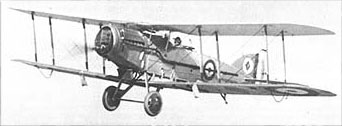
WWI Bristol Fighter plane which Keith Park flew. Permission The Aerodrome
By the end of the year ,the Bristol fighter pilot had scored 20 victories, despite being shot down once by anti-aircraft fire, and later by the German ace, Kurt Ungewitter, of Schusta 5. Park was the highest scoring ace to serve with No. 48 Squadron. For his displays of skill and gallantry, he was awarded the Military Cross and Bar, the Distinguished Flying Cross and the French Croix de Guerre.
After the First World War he remained with the RAF, passing through the RAF Staff College, becoming an air attaché in Buenos Aires (while there marrying a London girl Dorothy, “Dol”). Park became a Commanding Officer at one of Britain’s peacetime fighter stations, before eventually rising to the rank of Air Vice-Marshal. He was also chosen to be one of King George VI’s four aides-de-camp, riding behind the King in his Coronation procession in 1937.
Vital World War Two Campaigns
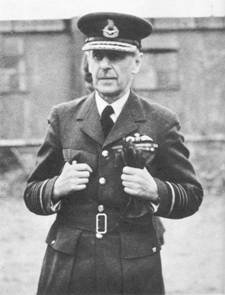
Lord Dowding. Permission Lord Dowding’s family
The air was to be the critical military arena of World War Two. The British stakes were high, the German threat was immense, and the internal political and operating environment with the Air Ministry and Churchill’s government was complex. At the beginning of WWII, Keith Park was appointed senior air staff officer to Hugh Dowding, the first commander of RAF Fighter Command. Dowding was behind the development of the Dowding System, which would be pivotal to success in the upcoming air war. Soon after, in January 1940, Park was appointed Commander-in-Chief of No.11 Group, the most important in Fighter Command. No.11 Group was assigned to not only defend the southern coastline of Britain and south-east England from enemy attack, but also to protect London, which it was obvious would be the prime target of the Luftwaffe at some stage of the war.
His first experience of action in WWII came when he was in charge of organising air-protection for the Allied evacuation of Dunkirk, on the French coast. The British Expeditionary Force and the French First Army had become cornered by advancing German forces and between 26 May and 4 June 1940 – nearly 350,000 troops needed to be evacuated by ship. The air support’s job was to intercept the Luftwaffe before they could attack the exhausted Allied troops on the beaches. It was a juggling act that required shuttling fighters, often crewed by pilots with limited experience and at the end of their fuel range, back and forth across the English Channel.
Park was often in the air himself over Dunkirk, spotting weak enemy positions and taking note of targets for his own pilots. When the order came to evacuate, Park was up in a Hurricane fighter making reconnaissance missions within range of German guns. He watched the last two British ships set sail while making a final survey. He was the last airman to leave.
Luftwaffe Repelled
With the Dunkirk evacuation at best a dignified retreat, Park’s real reputation was to rest on “the resounding success” of the Battle of Britain campaign. “Operation Sealion” was the codename for Germany’s intended invasion of England. The plan was for the initial air attack to destroy vital airfields, radar stations, ports and aircraft factories, and pave the way for a sea/land invasion. When the Luftwaffe attacked Britain in 1940 (flying nearly 1500 flights over England), Park controlled the urgent defence hour by hour, organising and managing his squadrons and men brilliantly.
The Dowding System, which Dowding conceived and oversaw, was an integrated air defence system which included radar, Royal Observer Corps, realtime raid plotting, and radio control of aircraft. Using the innovative radar defence system at Fighter Command, and with the help of the Observer Corp, Park, and the No. 11 Group, tracked German aircraft and advised British fighters, enabling them to intercept the raiders. When the early raids proved indecisive, the Luftwaffe switched the assault to London. Their efforts intensified, but so did their losses and, on 17 September 1940, Adolf Hitler postponed Operation Sealion indefinitely.
Park’s repelling of the German air attack was attributed to his leadership, judgement and exemplary co-ordination skills. Elevated in stature as well as esteem (he was 6ft 5, deserving credit for merely fitting in an aircraft cockpit), his judgement was based not only on astute decision making, but also a willingness to gain crucial information first hand. He often made reconnaissance missions within range of German guns and fighters, and was at one point forced to land when a British pilot mistook his plane for one of the enemy. His service was recognised with the Order of Commander of the Bath.

Permission The Battle of Britain 1940
Defence of Malta
After campaigning in Egypt in 1941, Park’s next big achievement came when he was charged with defending Malta. Just as the British Isles had been threatened earlier, Malta’s fate was now hanging in the balance. Malta was of strategic importance, controlling the vital sea-lanes between Italy and Africa. Its natural rocks and deep inlets concealed anchorages and submarine bases. Fighter planes based on Malta were also strategically positioned to defend convoys in the Mediterranean Sea.
When Park, now Air Marshal Park, arrived on the island, he found scarce food supplies, insufficient planes, and petrol supplies dependent on tankers getting through without being attacked by German fighters. In April 1942, the island suffered merciless air attacks from the Luftwaffe and Italian bombers. They were attempting to make the island “free for the storm” and open supply routes to Rommel’s army in North Africa. Instead of trying to defend the island, Park decided to counter-attack. The fighters that were sent out to intercept the German attack inflicted such heavy losses on the incoming German planes that Malta was saved.
Man of Action
Park’s temperament meant that he was never confined behind a desk in some sheltered headquarters. His willingness to take to the air himself, and forcefully state his opinions regardless of rank, meant that his colleagues found Park “fearless in words and deeds”. As Eugene Grayland states in Famous New Zealanders:
“The tall, lean New Zealander displayed the unusual combination of intense individual activity and initiative with a capacity for teamwork and co-ordination”.
With Malta saved, he was promoted to the post of Allied Air Commander-in-Chief, South East Asia. There, the air force performed a vital role in supplying stores to ground forces in testing jungle terrain where it was often difficult to find landing strips. Regularly flying into black monsoon nights and through enemy fire, Park summed up the achievements of the campaign with the telling phrase; “The army of the jungle advanced on the wings of the air force”.
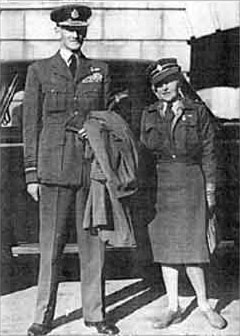
Permission The Evening Post, Wellington
Hero Retires to New Zealand with Honour
After WWII, Park was decommissioned and went to Argentina to work as trade ambassador to South America for the Hawker Siddley Aircraft Company. An opportunity arose to return to New Zealand as the company’s Pacific representative, and in 1948, Park came home to Auckland, eventually retiring and taking a prominent part in the Auckland City Council and other local body affairs. He died on the 6 February 1975, aged 82.
A section of the Auckland Museum of Transport and Technology is named in Park’s honour, as is the ‘Sir Keith Park IHC School’ in Auckland. He received honorary degrees and doctorates from Oxford University, was created a Knight Grand Cross of the Order of the Bath, and a Knight of the British Empire. He was also one of several distinguished men of the time, along with Winston Churchill and Lord Beaverbrook, to have locomotives named in their honour by the Southern Railway in Britain.
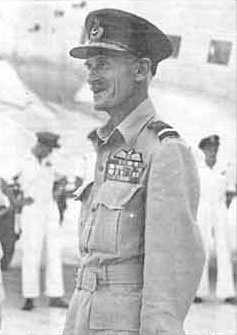
Permission The Evening Post, Wellington
The 80th Anniversary of the Battle of Britain and Sir Keith Park’s Contribution
There are many reasons why the 15th of September Battle of Britain Day still matters. This year is the 80th anniversary of the Battle of Britain fought over July to October 1940 and it will come at a particularly poignant time when we seek to pull ourselves together in the midst of the privations of a grim reaping Cofid-19.
A New Zealand WW1 fighter ace Keith Park Dowding began to develop new systems of air defence during the 1930s. He quickly perceived that in the Hurricane and Spitfire there existed a means of effective fighter defence. Park was testing the capability of new aircraft to create the basis of an operative air defence. Bases covering the country where new mono winged aircraft could be located were identified. Park and Fighter Command’s ace card was the development of Watson Watt’s radar.
The second element was the make- up of “The Few “pilots who made up Fighter Command when it was brought into existence immediately prior to the War. It drew on men from the then Empire and from countries occupied by the Nazis. The largest element in this polyglot group was more than 130 men from tiny New Zealand.
The third point is that it needed a man of outstanding skills who would be capable of blending the elements existing for defence effectively. Before joining the Royal Flying Corps in 1917 Park had proved himself an outstanding soldier. Park built on an innate technical ability quickly on joining The Flying Corps becoming a skilled pilot achieving the role of senior commander by 1918.
A fourth and crucial point is the mechanics of how Park masterminded what was the first allied victory in by September 1940. At Dunkirk Park’s Park made the tactical decision to seek to meet the attacking Luftwaffe away from the Beaches. He resisted demands to commit even more of their diminishing resources to the already lost Battle of France. The invention of Ultra enabled Park to gain crucial access to multiple German signals. Park’s aircraft were always present to meet German aircraft seeking out the Luftwaffe’s Dornier bombers. Park carefully restricted his flights to 12 aircraft against demand by others for large flights. However by September 1940 the Luftwaffe was systematically bombing Park’s crucial Group 11 airfields in the South East carrying the brunt of the battle. In early September Park was conceding that defeat followed by a German invasion might happen. However Hitler then decided to attack London taking the pressure off Park’s bases.
The fifth and final point is about Park himself. He was a man who had given himself completely to defeating the enemy and enjoying no qualms about the brutal “Boche” he faced. Such was the depth of this concentration that his wife’s Dorothy’s birthday escaped his attention. When this was pointed out to her Dorothy’s comment was Shakespearean; “It would be enough celebration for me that Keith had brought about the destruction of more German aircraft.” Yet perhaps this was an escape mechanism in coping with young men who at the peak of the battle had a usual life expectancy of just a week.
Park was his adaptable moving from responsibility for aerial support in the Middle East, to an omnipresent organising presence on Malta and playing a key role for the support of the ground troops in Burma. The crucial part of the Park legend were endless months often separated from his family where Park carried a responsibility where the consequences for any mistake could meant disaster for the allies.
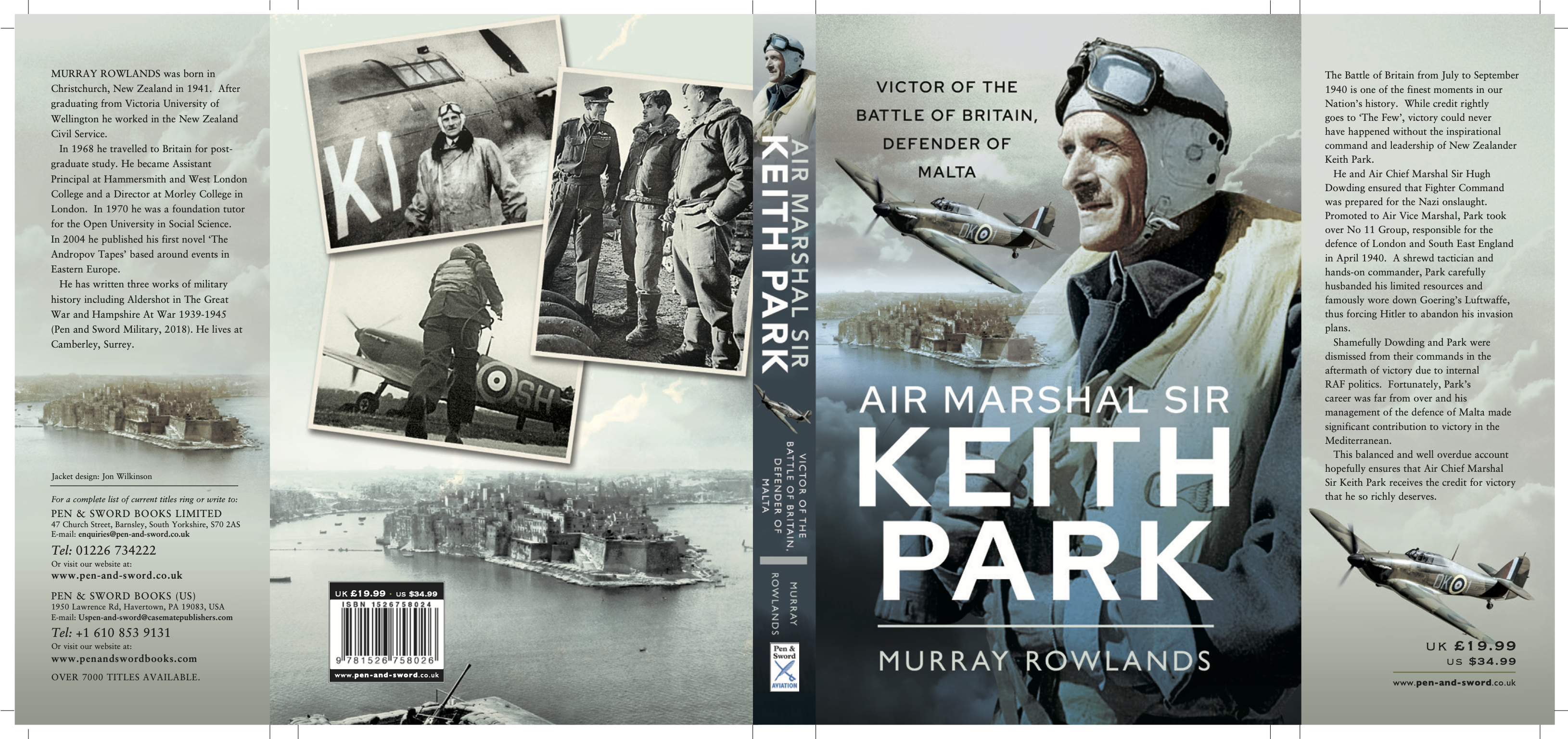
Book Cover, Air Marshal Sir Keith Park
Sources:
Web References:
For a short biography, (contains details of biography of Park by Vincent Orange) at: http://www.theaerodrome.com/aces/nzealand/park.php
[access May 2000]
For a biography from the “The Battle of Britain Historical Society” website (links to an excellent site on the history of The Battle of Britain): http://www.battleofbritain.net/section-3/appendix-17.html
[access May 2000]
Link to the Sir Keith Park Memorial Site at the Museum of Transport and Technology (MOTAT), Auckland: http://www.motat.org.nz/collections/aviation.htm.
[access May 2000]
For the DNZB entry on Keith Park see http://www.dnzb.govt.nz/dnzb/.
[access September 2006]
For more information about 34053 Sir Keith Park and its restoration.
Books:
Gordon McLauchlan (editor-in-chief). (1999) Illustrated History of New Zealand, Bateman, Auckland.
Pugsley, Chris. (1996) Scars of the Heart – Two Centuries of New Zealand at War, Bateman, Auckland.
Eugene Grayland. (1967) Famous New Zealanders, Whitcombe and Tombs Limited, Christchurch.
Recommended reading:
Orange, Vincent. (2001) Park: The Biography of Air Chief Marshall Sir Keith Park, Grub Street Publishing, London.
Sites which have linked to this story:
Australian Aviation Archive
Sir Keith Park Statue Campaign:
A major campaign is currently underway in the UK — supported by New Zealand — to erect a statue to commemorate
Sir Keith Park’s efforts in saving Britain during WWII. To support the campaign, visit the website http://www.sirkeithpark.com and sign the petition.













Keith Park is my hero
I am trying to trace the surviving next of kin of Sir Keith Park to inform him/her that my Air Cadet unit is naming a new IT/Computer Flight Suite in Sir Keith's honor which will serve up to 20 Air Cadets aged 13-20 as they learn about aviation from computer simulation. I believe that Sir Keith is one of the unsung heroes of the Royal Air Force and we are proud to be honoring his memory in this way. My father also served at 11 Group - RAF Uxbridge during WWII. Any assistance would be much appreciated. Phil, Flight Lieutenant Fording Bridge, Hampshire
Stumbled upon NZEDGE when I was looking for information on Lord Rutherford (it still burns me that Clinton said that Fermi split the atom!). I was really surprised to find that so many heroes have come from New Zealand. Nancy Wake, Keith Park, Charles Upham and so many more - I never learned anything of these people when I was at school. Thanks to the NZEDGE my identity as a Kiwi is stronger than ever before. Cheers from NYC, John. Equity Analyst New York, USA
Hi. Superb site. Well done for the piece on Keith Park. Don't forget General Freyburg - a very good ground commander and a loyal Kiwi. Regards Stuart. Stuart Goodacre, Journalist Lincoln, UK
"I just returned from a MOVE (mobility opportunities via education) conference in California. MOVE is an innovative curriculum that gets kids in wheelchairs up and walking in adaptive equipment. At the conference there were a group of Kiwis from the Sir Keith Park School in Mangere. This school has now become the first International MOVE model site. I was excited to see how quickly we Kiwis take a great idea and go with it. NZ has a very high standard of education and we are very adaptive too. If you have a special needs child (who can't walk independently yet) or know of one, please contact this school. Lets get our kids out of wheelchairs and in to taking part in life". Physiotherapist Englewood, Colorado, USA